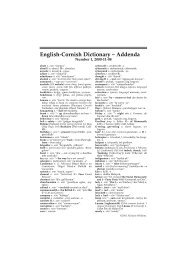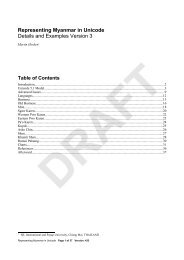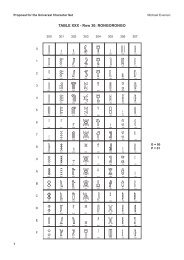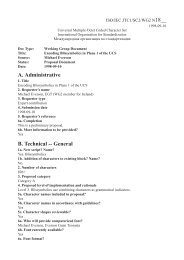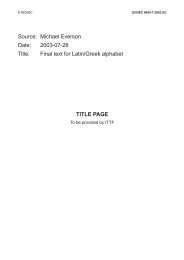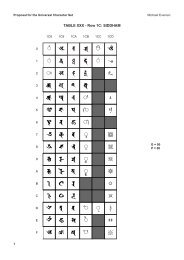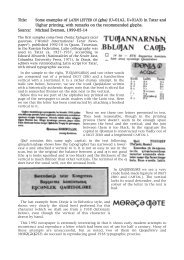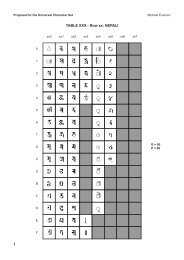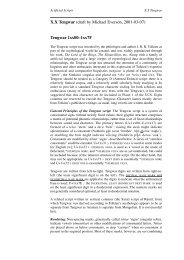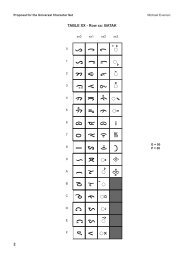ISO/IEC JTC1/SC2/WG2 N3194 L2/06-xxx - Evertype
ISO/IEC JTC1/SC2/WG2 N3194 L2/06-xxx - Evertype
ISO/IEC JTC1/SC2/WG2 N3194 L2/06-xxx - Evertype
Create successful ePaper yourself
Turn your PDF publications into a flip-book with our unique Google optimized e-Paper software.
REVERSED DZE ÑÖ is a common character, especially in early South Slavonic manuscripts and<br />
inscriptions, and particularly when used as a numeral. It co-occurs with Ö’, for example in the<br />
manuscripts NBKM 880 and RGB Sevast’janov 17; in the former ÇÉ is also found. See Figure 22.<br />
IOTA Üá has been used in scholarly literature since the nineteenth century to transcribe Glagolitic âπ.<br />
See Figure 23.<br />
DJERV àâ is the Old Cyrillic letter for the voiced palatal affricate, used particularly in the Bosnian<br />
manuscript tradition and in early Bosnian printings, where it also serves to indicate palatal l and n, by<br />
analogy with Italian gl, gn. The glyph is the ancestor of U+040B and U+045B ã€, but the two<br />
characters do not correspond either phonetically or etymologically. U+0402 and U+0452 Ç“ was in turn<br />
derived from 〠in 1819. DJERV cannot be unified with “ because the latter corresponds to it only<br />
partially, and besides, the two are sorted differently: â comes between ∏ and ∫, while “ comes between<br />
¥ and µ. See Figure 21.<br />
MONOGRAPH UK äã was incorrectly unified with Cyrillic £√; these two letters are not the same either<br />
historically or functionally. It is not unusual to find manuscripts using both √ and ã (see Figure 15).<br />
Both historically and in modern Church Slavonic, √ is also used as a numeral, but ã is only used as a<br />
letter: the two are therefore not interchangeable. Old Cyrillic ã originated as a ligated form of æ√, but<br />
cannot be unified with it as the two quickly diverged in usage. They are distinguished by orthographical<br />
conventions going back many centuries and formalized in modern Church Slavonic; according to these<br />
rules, the substitution of either √ or æ√ for ã is an error, and all three characters are required for proper<br />
Church Slavonic typesetting. See Figures 11, 12, 13, 15, 16, 17, 18, 20, 25, 27, 30.<br />
BROAD OMEGA åç is found alongside ‡· in most sixteenth- and seventeenth-century alphabets and is<br />
most frequently used with a distinctive supralinear element (in most typefaces unique to this character)<br />
for the vocative particle “O!”. However, in some alphabets (e.g. the 1631, 1653 and 1692 Primers) it<br />
appears without any supralinear element, and in the 1648 grammar is used to correspond to Greek ˆ in<br />
proper names derived from Greek, in which function it may take the same diacritics as the other vowel<br />
characters (cf. on f.93v in the paradigm of Jonah, vocative çÑ ıÜç´Ωæ, locative ·Ü ¬æº~ ıÜç´Ω„). This<br />
indicates that it is the body of the letter that is distinctive, not the supralinear element, and çÑ is not to<br />
be regarded as · + diacritic. See Figures 17, 20.<br />
NEUTRAL YER éè is used in transcribing documents where it is impossible to tell the difference between<br />
~ and ¨Ã (a common situation in late medieval Russian archival materials). See Figure 27.<br />
YERU WITH BACK YER êë is found alongside ´À in important manuscripts, such as the Dobrejsˇo<br />
Gospels. The ability to make the distinction between ë and À is of great importance to palaeography,<br />
and essential for a comprehensive palaeographic description of Cyrillic sources. See Figures 26, 40.<br />
IOTIFIED YAT íì is letter occurs in certain early Cyrillic texts, in which it is used contrastively with<br />
‚„. See Figure 40.<br />
REVERSED YU îï appears in some early Middle Bulgarian manuscripts and inscriptions, and has<br />
palaeographic and phonological significance. It is uncertain whether it has a common origin with ƌ.<br />
See Figures 22, 30.<br />
IOTIFIED A ñó occurs regularly from the earliest times to modern Church Slavonic. It is not to be<br />
unified with Øœ (which is a variant of ÊÁ), which is used as a distinct character alongside it in early<br />
modern Bulgarian. See Figures 15, 16, 17, 25, 26, 32.<br />
CLOSED LITTLE YUS òô is found in Old Church Slavonic and Middle Bulgarian manuscripts, and may be<br />
used contrastively with ÊÁ: in the Codex Supraslensis, for example, Á represents je˛ and ô represents e˛.<br />
See Figure 32.<br />
3





